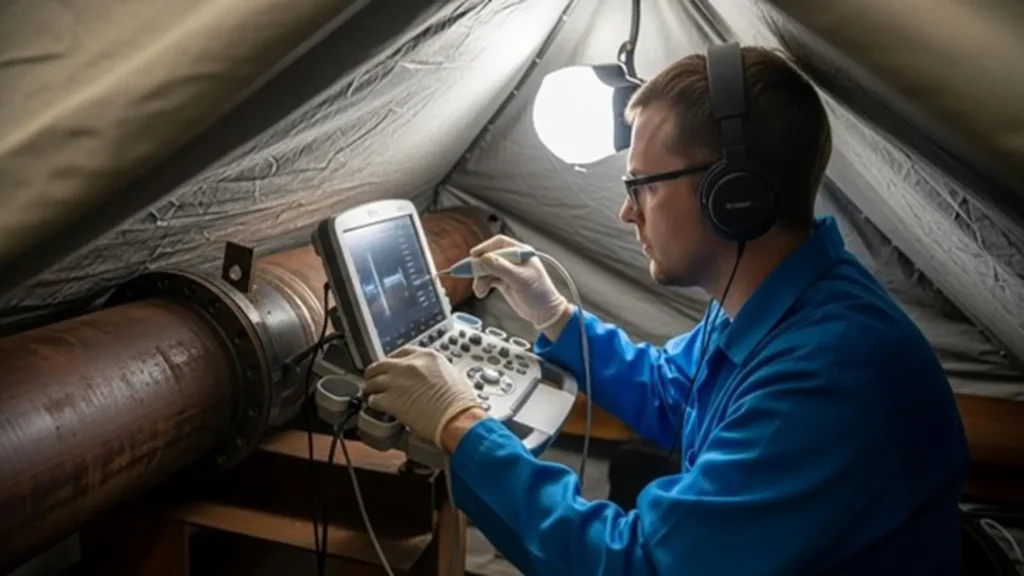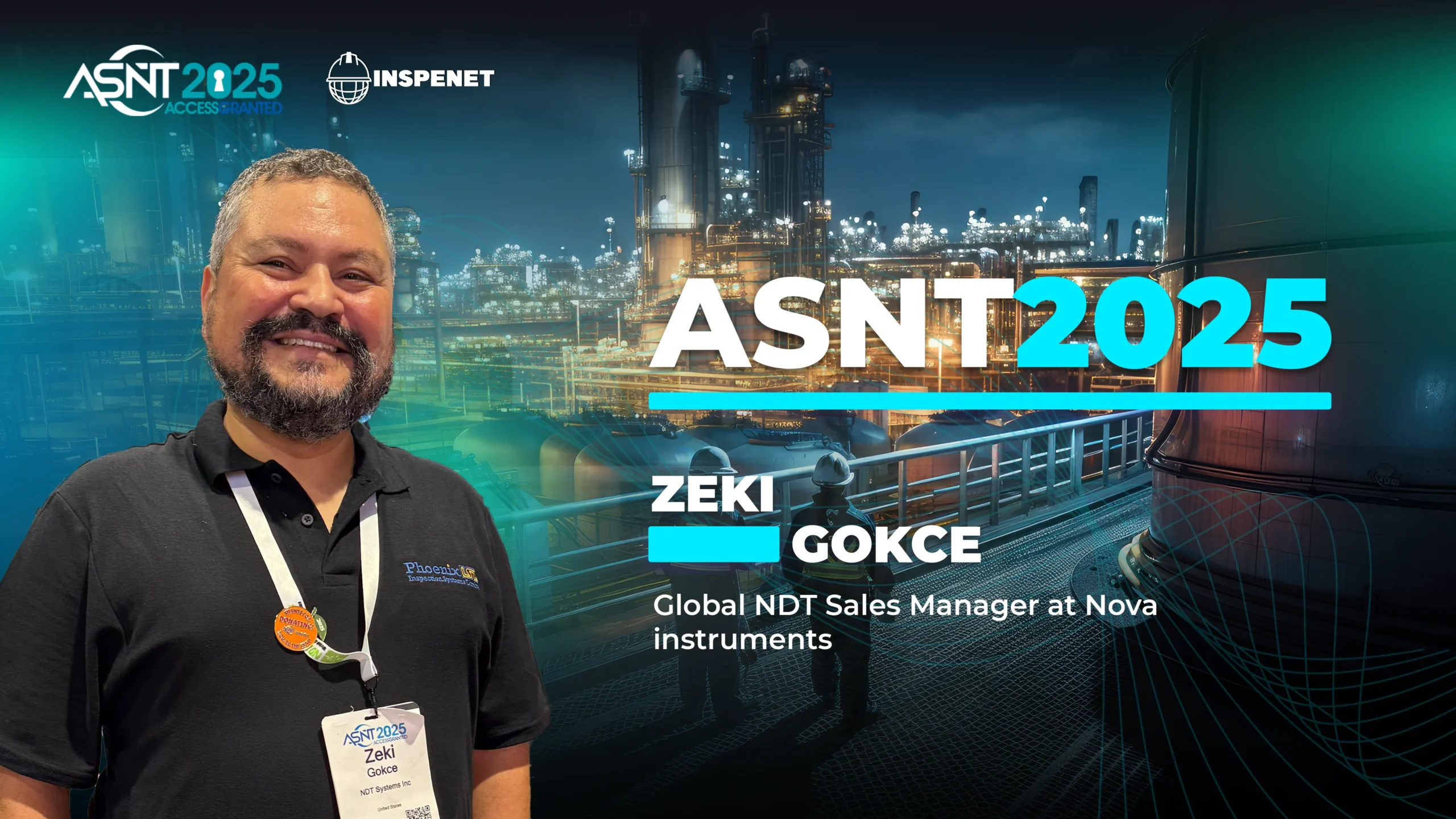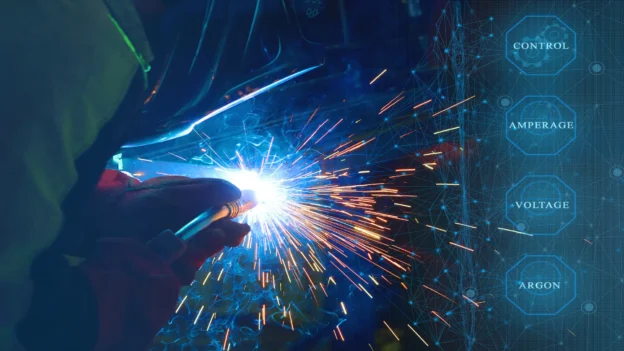Table of Contents
- What is pipeline welding?
- The importance of precision in pipeline welding
- Main standards applicable to pipeline welding
- Welding processes and applied technologies
- Weld inspection: Quality assurance and control
- Automation, digitization, and traceability in welding
- Experimental results and numerical modeling
- Featured case study
- Robotics and AI in the evolution of industrial welding
- Pipeline welder salary and projection
- Reliability: the cornerstone of industrial performance
- Future challenges and trends
- Conclusion
- References
- FAQs: About pipeline welding
- What is pipeline welding and what is it used for?
- What standards regulate industrial pipeline welding?
- How is a welder qualified under ASME IX?
- How is a welder qualified under ASME IX?
- What technologies are transforming welding?
- Why is digitization important in welding?
- What is the salary of an ASME IX certified welder?
- Which Inspenet tools strengthen inspections?
Pipeline welding is one of the most specialized and demanding areas of industrial engineering. From the construction of oil pipelines and petrochemical plants to power generation systems, it plays a fundamental role in ensuring the structural integrity, safety, and operational continuity of facilities.
Its execution demands high levels of precision, reliability, and technical expertise, attributes that distinguish professionals in this discipline and define the quality of modern industrial projects.
What is pipeline welding?
Pipeline welding is a specialized metallurgical process by which two or more pipe sections are permanently joined to form continuous systems for transporting fluids under pressure. This process is carried out through the controlled application of heat and, in some cases, filler metal, with the aim of achieving a homogeneous, resistant, hermetic metallurgical joint free of internal or external discontinuities.
Performing this type of welding requires the use of electric arc processes (such as SMAW, GTAW, GMAW, or FCAW), selected according to the type of base material, welding position, and service conditions. Bevel preparation, precise alignment, thermal control, and weld sequence (root, fill, and cap) are critical factors that determine the structural quality of the assembly.
The importance of precision in pipeline welding
Precision in the process depends on the manual skill of the pipe welder, as well as technical preparation, base material quality, electrode or wire selection, and equipment calibration. Therefore, training and certification are essential pillars in this profession.
Unlike other metal joining tasks, pipeline welding requires mastery of variables such as temperature, alignment, bead penetration, and gas protection. Even a slight deviation can cause internal defects (porosity, cracks, or lack of fusion) that compromise the strength and tightness of the system.
From a regulatory perspective, pipeline welding is governed by international standards such as ASME Section IX, API 1104, and AWS D10.12, D1.1, D1.6, which establish the qualification procedures, operating parameters, and acceptance criteria necessary to ensure the mechanical integrity, corrosion resistance, and operational safety of the system.
Main standards applicable to pipeline welding
| Standard | Scope of application | Type of welding regulated | Primary industrial sector | Key compliance aspects |
|---|---|---|---|---|
| ASME Section IX | Procedures and qualification of welders and welding operators | All welding processes (SMAW, GTAW, GMAW, SAW, FCAW) applied to pressurized equipment | Petrochemical plants, power generation, boilers, pressure vessels and industrial piping | Defines qualification criteria for welding procedure (PQR) and welder (WQTR); ensures mechanical integrity and traceability. |
| API 1104 | Welding of transportation and gathering pipelines for oil and gas | Manual, semi-automatic and automatic arc welding for carbon steel and low-alloy steel pipelines | Oil pipelines, gas pipelines and hydrocarbon transportation systems | Specifies procedures, inspections and acceptance criteria for field pipeline welding. Prioritizes operational safety and weld quality. |
| AWS D10.12 | Welding of stainless steel pipes and fittings | GTAW (TIG), GMAW (MIG/MAG) and plasma processes | Food, pharmaceutical, nuclear and cryogenic industries | Establishes requirements to avoid contamination and corrosion in stainless steel joints. Includes guidelines for cleaning, inert gas purging and thermal control. |
| AWS D1.1 | Welding of carbon steel and low-alloy steel structures | SMAW, FCAW, SAW and GMAW processes in metal structures | Construction, industrial structures, supports, frames and power plants | Defines geometric tolerances, joint preparation and destructive and non-destructive testing for steel structures. |
| AWS D1.6 | Welding of stainless steel structures | GTAW, GMAW, SMAW and FCAW processes | Chemical plants, pharmaceutical industry, food processing and hygienic applications | Regulates qualification, design and acceptance criteria for stainless steel welds. Emphasizes cleanliness and corrosion resistance requirements. |
Welding processes and applied technologies
Technological advances have radically transformed welding applied to pipes. Traditional methods such as SMAW (Shielded Metal Arc Welding) have given way to more controlled and efficient techniques, including:
- SMAW (Shielded Metal Arc Welding): a manual process widely used in the field.
- GTAW (Gas Tungsten Arc Welding or TIG): provides high quality and control in stainless steels.
- GMAW (Gas Metal Arc Welding or MIG/MAG): suitable for continuous and automated production.
- FCAW (Flux Cored Arc Welding): ideal for heavy structures and adverse climates.
- SAW (Submerged Arc Welding): preferred for thick sections.
- Welding automation: Automated orbital welding, used in the pharmaceutical and nuclear sectors where precision is critical.
These methods combine digital control, temperature sensors, and real-time monitoring, resulting in uniform, defect-free welds with a superior level of reliability.
Weld inspection: Quality assurance and control
Weld inspection is a crucial part of the welding process, as it ensures that each joint complies with the safety, structural integrity, and traceability standards required in energy and industrial projects.
Before starting any welding operation, the following fundamental aspects must be verified:
Review of the welding technique
The selection of the process (SMAW, GTAW (TIG), or GMAW (MIG)) depends directly on the type and thickness of the pipe material, as well as the environmental and operating conditions that affect arc stability, penetration, and bead quality. This choice must be documented in the corresponding WPS (Welding Procedure Specification).
Verification of welding equipment
The equipment used must be calibrated, certified, and in optimal operating condition, in accordance with applicable standards and manufacturer specifications. Metrological control of power sources, meters, pressure gauges, and inspection equipment ensures process reliability and repeatability of results.
Personnel qualification and quality assurance
Pipeline welding requires professionals to be qualified and certified by AWS and other international standards such as ASME Section IX, which regulates welder procedures and competencies.
Each welded joint must be performed by personnel who have demonstrated their skill through practical tests and trials in accordance with an approved Welding Procedure Specification (WPS).
The equipment inspector, responsible for verifying this competency, must review the documentation and test results in accordance with Article III of the code, ensuring that the welder’s qualification meets the technical, regulatory, and traceability requirements demanded by the industry.
Appendix: Welder evaluation checklist (ASME IX): To support inspection and quality control work, Inspenet provides this free technical document:
Recommendation: Use it as part of your quality management system or technical welding training.
Preparation of the joint to be welded
Joint preparation comprises six critical phases: initial inspection, cleaning, cutting, beveling, alignment, and final verification. Each one directly influences root penetration, bead geometry, and the structural integrity of the welded joint.
An error at this stage cannot be corrected during execution, so it must be documented through pre-weld control records.
Weld testing and inspection
For the final approval and acceptance of a welded joint, non-destructive testing (NDT) is applied to verify the internal and surface integrity of the joint without affecting its functionality.
- Among the most relevant methods is ultrasound (UT), a technique that detects internal discontinuities with high precision, especially in thick welds. Within this category, Phased Array Ultrasonic Testing (PAUT) stands out, an advanced variant that uses multiple electronically steerable ultrasonic beams to generate detailed images of the weld volume. This technology offers higher resolution, coverage, and defect characterization capabilities compared to conventional ultrasound. The following image shows a representative example of the use of digital techniques in modern critical weld inspection.

- Industrial radiography (RT): Used to identify volumetric defects such as inclusions, pores, or lack of fusion.
- Penetrant testing (PT) and magnetic particle testing (MT): Reveal surface imperfections, cracks, or leaks in ferrous and non-ferrous materials.
- Eddy Current (EC): An effective electromagnetic technique for detecting surface or subsurface cracks in conductive materials.
- Automated computer vision inspection: An emerging technology that combines artificial intelligence and high-resolution cameras for digital analysis of welds and early detection of defects.
Automation, digitization, and traceability in welding
These intelligent platforms integrate sensors, machine vision cameras, and artificial intelligence algorithms capable of recording, in real time, the essential parameters of the process (temperature, voltage, speed, and weld geometry), linking them to the welder, the equipment, and the corresponding WPS.
Through this digital traceability, each weld generates a verifiable and auditable history that strengthens asset integrity management. In critical sectors such as oil and gas, electric power, and petrochemicals, this technology ensures operational safety and service continuity.
Rather than replacing welders, digitization redefines their role: certified professionals now also interpret data, calibrate robotic systems, and optimize automated processes under Industry 4.0 standards.
To learn more about this innovative technology, we invite you to watch the interview “Automated Ultrasonic Inspection Optimizes Weld Quality”, presented during the ASNT 2025 conference. In this session, Nova Instruments, represented by its Global Sales Manager for NDT, Zeki Gokce— showcases an advanced solution that is transforming ultrasonic inspection processes in pipeline welding applications.
Watch the full interview here:

Experimental results and numerical modeling
Scientific research has provided increasingly accurate models for understanding the thermal and mechanical behavior of welds. Studies based on finite element methods (FEM) allow the distribution of stresses, deformations, and heat-affected zones to be simulated.
Thanks to these simulations, engineers can:
- Predict the occurrence of residual stresses or distortions.
- Optimize current, voltage, and feed rate parameters.
- Evaluate the microstructure and hardness of the resulting joint.
- Reduce the risk of failure during operation or service.
Several recent articles published in ScienceDirect and Welding Journal have demonstrated how the integration of experimental and numerical data improves the efficiency and reliability of pipeline welding processes, especially in critical applications such as subsea gas pipelines or cryogenic systems.
Featured case study
Cryogenic welding in high manganese steels
A recent study published in ScienceDirect (2025) analyzed the microstructural and mechanical behavior of gas metal arc welded (GMAW) joints in Fe–23Mn–0.45C–3.5Cr cryogenic steel, used in liquefied natural gas (LNG) systems.
The research combined experimental testing and finite element method (FEM) numerical simulation to evaluate how residual stresses and Cr₂₃C₆ carbide precipitation in the heat-affected zone (HAZ) influence the toughness and hardness of the material.
The results showed abnormal grain growth, high residual stress (~520 MPa), and a significant reduction in toughness near the fusion line, all of which are critical factors in the performance of cryogenic welds.
The study demonstrates that integrating FEM modeling with experimental data allows for the optimization of thermal parameters, minimization of defects, and improvement of structural reliability in welds subjected to low temperatures. For further reading: Read the full study on ScienceDirect.
Robotics and AI in the evolution of industrial welding

Intelligent welding robots, equipped with laser sensors, 3D vision systems, and machine learning algorithms, can adjust welding parameters (voltage, speed, penetration, and temperature) in real time to maintain consistent quality even on complex geometries or dissimilar materials.
In highly critical sectors such as oil and gas, nuclear, and cryogenic, robotic orbital welding has become the standard. These systems guarantee uniform welds, reduce human risk, and optimize the traceability of each joint.
In turn, the development of digital twins allows the creation of virtual replicas of welding processes, where engineers can simulate thermal conditions, distortions, and residual stresses before actual execution. This predictive approach reduces rework, improves thermal efficiency, and shortens calibration times.
AI is also driving cognitive control of the process, analyzing large volumes of welding data to predict defects or deviations before they occur. Thus, the system not only automates, but also continuously learns, corrects, and optimizes.
In the era of Industry 4.0, welding is becoming a hybrid discipline between metallurgical engineering and data science, where mechanical precision is combined with machine learning to ensure greater reliability, productivity, and operational safety.
Pipeline welder salary and projection
Pipeline welder salaries vary significantly depending on the country, certification, and level of experience, but in general, it is considered one of the best-paid trades in the industrial sector.
According to global estimates from technical portals and welding associations:
- In Latin America, salaries range from USD 1,200 to 3,500 per month, depending on the project and working conditions.
- In the United States and Canada, ASME or AWS-certified professionals can earn more than USD 80,000 per year, especially in the oil and gas sector.
- Professionals specializing in orbital or automated welding can earn even higher incomes due to the shortage of skilled labor.
This trend reflects the high demand for technical personnel with expertise in precision, inspection, and quality control, making pipe welders key figures in energy and manufacturing infrastructure.
Reliability: the cornerstone of industrial performance
In the industrial context, reliability is the key indicator of a successful weld. Each joint must withstand extreme pressures, vibrations, and temperature changes without compromising operational safety.
Companies in the energy and petrochemical sectors implement integrity management programs, where the condition of welds is constantly evaluated through continuous monitoring and predictive analysis. The goal is to anticipate any deterioration, ensuring continuity of operations and environmental protection.
Pipeline welding, in this sense, stands as a comprehensive engineering discipline that combines technical knowledge, quality control, and strategic vision.
Future challenges and trends
The future of industrial welding is moving towards intelligent automation and sustainability. Among the most notable trends are:
- Use of advanced materials (duplex steels, superalloys, and light alloys).
- Incorporation of the Internet of Things (IoT) for real-time monitoring.
- Integration of clean energy and reduction of emissions during the process.
- Training through augmented reality and virtual simulators to educate new generations of welders.
hese advances are redefining the role of the professional, requiring a balance between traditional manual skills and mastery of digital tools.
Conclusion
Pipeline welding represents the meeting point between human skill and precision engineering. It is a discipline that requires technical knowledge, concentration, and a commitment to quality. In an increasingly automated industry, its value does not diminish: it evolves.
Today’s pipeline welder not only performs metal joints, but also operates intelligent systems, interprets data, and ensures the reliability of critical infrastructure for energy, industry, and society.
Get trained with Inspenet Academy and improve your technical profile!
References
- ScienceDirect (2025). “Numerical and experimental simulation study on the microstructure, residual stress, and mechanical properties of arc-welded joints of high-manganese Fe–Mn–C–Cr cryogenic steel.”
- Available at: https://www.sciencedirect.com/science/article/pii/S2238785425001140
Semlis Weld: https://www.senlisweld.com/es/ - ASME Section IX: https://www.asme.org/codes-standards/find-codes-standards/bpvc-ix-bpvc-section-ix-welding-brazing-fusing-qualifications/2025/print-book
FAQs: about pipe welding
FAQs: About pipeline welding
What is pipeline welding and what is it used for?
Pipeline welding is a metallurgical process by which sections of pipe that transport fluids under pressure are permanently joined together. It is used in oil pipelines, refineries, chemical plants, and power generation systems.
What standards regulate industrial pipeline welding?
The main international standards are ASME Section IX, API 1104, and AWS D1.1 / D10.12 / D1.6, which establish the qualification procedures, tests, and acceptance criteria for the process and the welder.
How is a welder qualified under ASME IX?
The welder must perform a practical test following an approved WPS. The test joint undergoes visual inspections and mechanical tests (bending, tensile, or NDT). If it meets the requirements, a WPQ (Welder Performance Qualification) record is issued.
How is a welder qualified under ASME IX?
The welder must perform a practical test following an approved WPS. The test joint undergoes visual inspections and mechanical tests (bending, tensile, or NDT). If it meets the requirements, the WPQ (Welder Performance Qualification) record is issued.
What technologies are transforming welding?
The most notable technologies are robotic automation, orbital welding, digital inspection with AI, electronic traceability, and the use of digital twins for predictive monitoring.
Why is digitization important in welding?
Because it allows all process parameters to be recorded in real time, linking each joint to the welder, equipment, and material used. This ensures transparency, quality control, and regulatory compliance.
What is the salary of an ASME IX certified welder?
It depends on the country and specialization. In Latin America, they can earn between USD 1,200–3,500 per month, while in the US or Canada, they can earn over USD 80,000 per year, especially in the energy sector.
Which Inspenet tools strengthen inspections?
You can download the ASME IX Checklist – Welder Evaluation and watch the video “Ultrasonic inspection optimizes welds” on Inspenet TV, both resources designed to improve quality management and traceability in the field.


